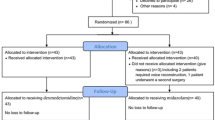Abstract
Background: Dexmedetomidine reduces the dose requirements for opioids and anaesthetic agents. The purpose of this study was to evaluate the effect of a single pre-induction intravenous dose of dexmedetomidine 1 μ/kg on cardiovascular response resulting from laryngoscopy and endotracheal intubation, need for anaesthetic agent and perioperative haemodynamic stability.
Methods: Fifty patients scheduled for elective minor surgery were randomised into two groups (dexmedetomidine group and placebo group, n = 25 in each group). During and after drug administration, the Ramsey sedation scale was applied every 5 minutes. Fentanyl 1 μ/kg was administered to all patients and thiopental was given until lash reflex disappeared. Anaesthesia continuation was maintained with 50% : 50%, oxygen : nitrous oxide. Sevoflurane concentration was adjusted to maintain systolic blood pressure within 20% of preoperative values. After extubation, the Steward awakening score was applied at 5 and 10 minutes. Haemodynamic parameters and adverse effects were recorded every 10 minutes for 1 hour after surgery.
Results: During intubation the need for thiopental and sevoflurane concentration were decreased by 39% and 92%, respectively, in the dexmedetomidine group compared with the placebo group. In all groups, blood pressure and heart rate increased after tracheal intubation; both were significantly lower in the dexmedetomidine group than in the placebo group (p < 0.05). Fentanyl requirement during the operation was 74.20 ± 10.53μg in the dexmedetomidine group and 84.00 ± 27.04μg in the placebo group (p < 0.05). At 5 minutes, the Steward scores were >6 in 56% of the dexmedetomidine group and in 4% of the placebo group (p < 0.05). At 10 minutes, sedation scores were ≥4 in all patients in the dexmedetomidine group (p < 0.05). Arterial blood pressure and heart rate in the postoperative period were significantly lower in the dexmedetomidine group compared with the placebo group (p < 0.05).
Conclusion: Preoperative administration of a single dose of dexmedetomidine resulted in progressive increases in sedation, blunted the haemodynamic responses during laryngoscopy, and reduced opioid and anaesthetic requirements. Furthermore, dexmedetomidine decreased blood pressure and heart rate as well as the recovery time after the operation.









Similar content being viewed by others
References
Aho M, Lehtinen AM, Erkola O, et al. The effect of intravenously administered dexmedetomidine on perioperative hemodynamics and isoflurane requirements in patients undergoing abdominal hysterectomy. Anesthesiology 1991; 74: 997–1002
Virtanen R, Savola JM, Saano V, et al. Characterization of the selectivity, specificity and potency of medetomidine as an α2 adrenoceptor agonist. Eur J Pharmacol 1988; 150: 9–14
Aantaa R, Kanto J, Scheinin M. Dexmedetomidine, an α2 adrenoceptor agonist, reduces anaesthetic requirements for patients undergoing minor gynaecologic surgery. Anesthesiology 1990; 73: 230–5
Mallampati SR, Gatt SP, Gugino LD, et al. A clinical sign to predict difficult tracheal intubation: a prospective study. Can Anaesth Soc J 1985; 32: 429–34
Ramsey MAE, Savage TM, Simpson BRJ. Controlled sedation with alphaxalone-alphadolone. BMJ 1974; 2: 656–9
Goldberg ME, Larijani GE, Azad SS, et al. Comparison of tracheal intubating conditions and neuromuscular blocking profiles after intubating doses of mivacurium chloride or succinylcholine in surgical outpatients. Anesth Analg 1989; 69: 93–9
Jalonen J, Hynynen M, Kuitunen A, et al. Dexmedetomidine as an anesthetic adjunct in coronary artery bypass grafting. Anesthesiology 1997; 86: 331–45
Gregory GA. Pediatric anesthesia. 2nd ed. New York: Churchill Livingstone Inc., 1989: 2
Bloor BC, Denham SW, Bellewille JP. Effects of intravenous dexmedetomidine in humans. II: hemodynamic changes. Anaesthesia 1992; 77: 1134–42
Aantaa R. Assessment of the sedative effects of dexmedetomidine, an α2 adrenoceptor agonist, with analysis of saccadic eye movements. Pharmacol Toxicol 1991; 68: 394–8
Aho M, Scheinin M, Lehtinen AM. Intramuscularly administered dexmedetomidine attenuates hemodynamic and stress hormone responses to gynaecologic laparoscopy. Anesth Analg 1992; 75: 932–9
Lawrence CJ, Lange S. Effects of single pre-operative dexmedetomidine dose on isoflurane requirements and perioperative haemodynamic stability. Anaesthesia 1997; 52: 736–44
Ebert TJ, Hall JE, Barney JA. The effects of increasing plasma concentrations of dexmedetomidine in humans. Anesthesiology 2000; 93: 382–94
Belleville JP, Ward DS, Bloor BC. Effects of intravenous dexmedetomidine in humans: I. Sedation, ventilation and metabolic rate. Anaesthesiology 1992; 77: 1125–33
Hall EJ, Uhrich TD, Barney JA, et al. Sedative, amnesic and analgesic properties of small dose dexmedetomidine infusions. Anesth Analg 2000; 90: 699–705
Jaakola ML. Dexmedetomidine premedication before intravenous regional anaesthesia in minor outpatient hand surgery. J Clin Anesth 1994; 6: 204–11
Mantz J. Dexmedetomidine. Drugs Today (Barc) 1999; 35 (3): 151–7
Bloor BC, Flack WE. Reduction in halothane anaesthetic requirement by clonidine, an α2 adrenergic agonist. Anesth Analg 1982; 61: 741–5
Aantaa R, Kanto J, Scheinin M. Dexmedetomidine premedication for minor gynaecologic surgery. Anesth Analg 1990; 70: 407–13
Aho M, Erkola A, Scheinin H, et al. Effect of intravenously administered dexmedetomidine on pain after laparoscopic tubal ligation. Anesth Analg 1991; 73: 112–8
Weinbroum AA, Ben-Abraham R. Dextromethorphan and dexmedetomidine: new agents for the control of perioperative pain. Eur J Surg 2001; 167: 563–9
Scheinin H, Virtanen R, MacDonald E. Medetomidine, a novel adrenoceptor agonist: a review of its pharmacodynamic effects. Prog Neuropsychopharmacol Biol Psychiatry 1989; 13: 635–51
Jaakola ML, Salonen M, Lehtinen R, et al. The analgesic action of dexmedetomidine: a novel α2 adrenoceptor agonist: in healthy volunteers. Pain 1991; 46: 281–5
Peden CJ, Cloote AH, Stratford N, et al. The effect of intravenous dexmedetomidine premedication on the dose requirement of propofol to induce loss of consciousness in patients receiving alfentanil. Anaesthesia 2001; 56: 408–13
Acknowledgements
The authors thank Dr Fatih Kora for his contributions to the statistical analysis. No funding was received for this study, and the authors have no potential conflicts of interest that are directly relevant to the contents of this manuscript.
Author information
Authors and Affiliations
Corresponding author
Rights and permissions
About this article
Cite this article
Yildiz, M., Tavlan, A., Tuncer, S. et al. Effect of Dexmedetomidine on Haemodynamic Responses to Laryngoscopy and Intubation. Drugs R D 7, 43–52 (2006). https://doi.org/10.2165/00126839-200607010-00004
Published:
Issue Date:
DOI: https://doi.org/10.2165/00126839-200607010-00004




